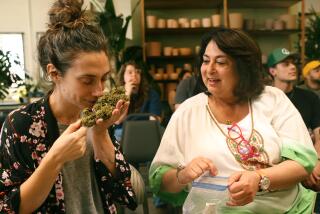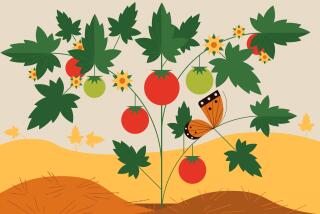Grow them because you can
In the supermarket, artichokes are all big, meaty specimens. In the garden, the state of chokes is a rapidly changing picture as the March-to-May season elapses. The first blooms, called the “crown set” or “kings,” are also such big flowers that they constitute meals in themselves. But after harvesting, the chokes become progressively smaller. The second set will be three-quarters the size of the kings, the next half the size, the third a spray of plebs.
These steadily diminishing returns make it hard to argue that we should grow artichokes at home, particularly with all those kings in the supermarkets. But we should, if for no other reason than we can. California has the only climate in these 50 states ideally suited to growing them. Artichokes like it hot but not too hot, and cold but not too cold. Their favorite temperature range is 75 degrees in the day and 55 at night, with an extreme high of 85 and low of 45.
Sound like anywhere but Southern California? (Florida’s climate is too sweaty and extreme, hee-hee.)
Then there is the flavor. Over the years, food chemists have likened the flavors and odors of the artichoke’s volatile compounds to dry grass, cedar, smoke, parsley, roasted caramel, hyacinth, sweet corn, sweat, must and pepper. If all of these qualities were rolled into one, that might amount to the taste of artichokes. UC Davis farm advisor and artichoke breeder Keith Mayberry uses the term “nutty.”
This unique flavor comes in a suitably fabulous package. The artichoke’s botanical name, Cynara scolymus, identifies it as a special breed of cardoon, which somehow sprouted thistles. Its green-gray foliage is large, grandiose and serrated at the edges, very like the leaves of its delicious cousin the dandelion. But unlike dandelions, the artichoke needs space. In an agreeable setting, it can grow from 3 feet to 6 feet tall, and 3 feet to 4 feet across. Its deep roots will tolerate big pots, provided it is watered often, which is good, because it looks gorgeous tufting out of big terra cotta planters.
Artichokes have the same growing cycle as dandelions, bursting forth in spring and fall, limping through high summer and dying back during winter. The time to start them is now. This can be done any of three ways. The lazy way (and my own) is to buy seedlings, either the small- or medium-size specimens now appearing in garden centers. The almost-as-lazy way is to take side shoots off a healthy mother plant and root them. They will take easily in decent garden soil. Or you can start a new plant from seed.
This third approach requires risk analysis. A tour of seed catalogs found repeated warnings that artichoke seeds don’t always deign to germinate, and when they do, they can produce up to 40% sterile and albino culls. But people willing to go through this will enjoy more choice of variety.
Most artichoke seedlings in nurseries are the Green Globe variety, and good they are. However, leading seed companies, from Burpee to the more heirloomist sources, also now routinely offer the Italian Violetta type, which has purple-tinted chokes.
The Imperial is Mayberry’s favorite, as it should be. He and UC Davis colleague Wayne Schrader bred it. It’s thornless, with good germination rates demanded by Central California farmers. It was also bred for use as an annual. As such, Mayberry vows, if started now, the Imperial should be capable of flowering in one year. Seedlings planted in April should grow during the summer, form buds in the autumn, and produce chokes either in autumn or spring.
My own 5-gallon seedling bought from a Hollywood Home Depot flowered in early summer the first year. The following advice is the result of trial and error: The chokes should be cut about 5 inches down the stem when the petals, called “bracts,” are tightly furled. This discourages earwig occupancy. The long stem can then be trimmed back. If the bracts have started to open, the choke may be bitter and woody, and is probably best left on the plant as a show bloom. This is a good cause. In full bloom, artichokes reveal stunning, cornflower-blue corollas.
Artichoke seeds are available from most good seed catalogs. For more about growing them, go to the UC Davis public service Web site, vric.ucdavis.edu.
Tomatoes galore
Over the course of spring, Burkard Nurseries in Pasadena will carry more than 300 types of tomatoes, from Abraham Lincoln Original to Zapotec Pink Ribbed. All are available for inspection on the nursery’s Web site, www.burkardnurseries .com/index.htm.
The downside to growing heirloom tomatoes is that many lack resistance to common soil-borne fungi. Owner Frank Burkard Jr. says one precaution is to wait until the second or third week of April to plant out seedlings. Another is to beware of early-season over-watering.
Burkard Nurseries, 690 N. Orange Grove Blvd., Pasadena; (626) 796-4355.
... and more
Garden designer Scott Daigre adds that it is always best to “harden off” nursery seedlings by keeping them on your terrace, but bring them indoors for cold nights before planting them out. He is one of the organizers of Tomatomania, a tomato sale specializing in exotica, now returning for the second year. It will have 175 varieties, on-site experts, planting amendments, and, says Daigre, a new breed: the Julia Child. He doesn’t know what that tomato tastes like yet.
March 19 to 23, 9 a.m. to 5 p.m. daily, at Tapia Bros. Farm, 5251 Hayvenhurst Blvd., Encino, near the intersection of Hayvenhurst and Burbank boulevards, just off the 101 Freeway.


